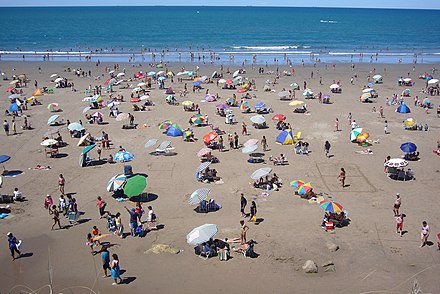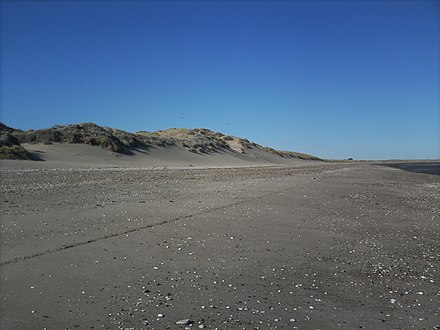San Antonio Oeste - city in Río Negro, Argentina
San Antonio Oeste is the most important port town in Rio Negro Province of Argentina.
Understand
San Antonio Oeste is the main fishing port in Northern Patagonia, and locally well known for its beaches in the suburb of Las Grutas. The town is on the shore of the Bay of San Antonio, a shallow extension of the San Matías Gulf, and has 20,000 inhabitants.
The city is divided into three main localities: the proper San Antonio Oeste at the western shore of the bay, the port of San Antonio Este at the eastern shore, mainly used for the export of fruits and vegetables, and the Las Grutas beach resort 10 km south-west of the city centre. There are some more recent smaller resorts with very few services, most of them south of Las Grutas, while one was built at the Conchillas beach in San Antonio Este.
Whether the proper San Antonio Oeste is a quiet and lovely town, the Las Grutas beach resort becomes very crowded in January and February, as it has converted into a "in" place since the 1990s. It is mostly visited by families and young people. Best time to visit is late summer and early autumn, when the water is very warm - it's the warmest of Argentina because of the sunny climate of the area and the relatively shallow waters - and there are less tourists.
Get in
San Antonio has an airport, but it is (as of Jan 2020) not served by passenger flights. Nearest airports are in Viedma and Puerto Madryn, from where you can take a bus.
Most people will go to San Antonio by bus, with connections to all important cities in Argentina. There are two bus terminals, one in San Antonio proper and the more active one in Las Grutas.
A inexpensive train with only regular service operates on the line between Viedma and San Carlos de Bariloche twice per week, stopping at San Antonio.
Get around
Las Grutas and San Antonio Este are connected to San Antonio Oeste by paved roads.
There are several local buses. The main line between San Antonio and Las Grutas runs every 30 min until late at the evening. Another service connects San Antonio Oeste to the port of San Antonio Este and Las Conchillas beach, three times per day.
See
San Antonio is mostly a modern town with largely uninteresting buildings in the centre, with two exceptions: the neo-classical Municipality and the neo-baroque Church.
The harbour section in the proper San Antonio Oeste is full of picturesque old wooden houses, but most of the area is run down.
The port installations of San Antonio Este cannot be visited.
Do
The beaches are the main attractions of town and surroundings. Only the Las Grutas main beach becomes really crowded. The other beaches are quiet and beautiful alternatives. Visitors can practice diving and fishing in many areas. The San Antonio Bay loses nearly all its water when the tide is low, and nature lovers can make large walks "on the ground of the sea".
Las Grutas

- The Playa Central is surrounded by rocks, with wider sandy areas and some small caverns. It is often crowded and becomes very small when tide is high. Stairways, the so-called Bajadas, go down the rocks to the beaches; they are numbered from north to south. There are several bars and other activities at the beach.
- Beaches north of the center are rocky, with less sand, but interesting rock formations and caverns.
- About 4 km south of Las Grutas is the very picturesque Playa Piedras Coloradas surrounded by red rocks.
- Playa El Fuerte is located even more south, it's sandy and has a nice view of a rocky mountain near the coast called El Fuerte.
San Antonio Este
- The brightly white Playa Las Conchillas is the most attractive beach of the area, with a mix of sand and milled clam shells. It is located east of the town and has some accommodation and very few services, there is also a little sea lion colony.
- The main beach north and south of the port is sandy and you get a nice view of the port installations.
- Punta Perdices, a small peninsula, and the bay Caleta Falsa are located north of the town, they're strikingly beautiful locations with very blue water and white beaches, but there is not much sand and there are no services.
San Antonio Oeste
- The central beach only has water when tide is high. Water temperature is even higher than in Las Grutas.
- Playa La Mar Grande lies south of the town center, about 2 km west of the ALPAT factory and has no services. When tide is low it is almost 2 km wide, while at high tide access is much easier.
Buy
Las Grutas has a pedestrian mall with dozens of shops, although they tend to be expensive. Most of them close between Easter vacations and December. At summer evenings, there is a craft market.
In San Antonio Oeste, the main commercial street is San Martín, above all west of the main square. There are fewer shops than in Las Grutas, but they're also cheaper and open the year round. San Antonio Este has only basic services.
Eat
Many restaurants offer good fish specialities. They are concentrated in Las Grutas but San Antonio Oeste itself also offers good choices. In San Antonio Este, there are also some small restaurants.
Drink
In summer, Las Grutas has an active nightlife, but music in the clubs tends to be poor and chart-heavy. The rest of the year there are a few pubs and a disco in San Antonio Oeste.
Sleep
Most visitors of Las Grutas sleep in rented apartments. There is a still relatively small, but growing number of hotels and several large camping grounds. It is highly recommended that you reserve your place in advance, even in the campings (above all at weekends, when many families of the Rio Negro Province visit the town).
In the proper San Antonio Oeste and San Antonio Este the situation is less tense, but there were cases with the whole area without a single free bed.
Connect
Internet and locutorios (telephone centers) exist in all parts of the city.
Go next
- A little known and attractive area is Sierra Grande, 120 km south of San Antonio, with a sea-lion and penguin colony, nice desert hills with red rocks, the very attractive Playas Doradas beach and much tranquility.
- Towards the east, you can reach Viedma and Carmen de Patagones, the oldest cities in Patagonia, and several small seaside resorts which become accessible via Ruta Provincial 1. This area is very attractive for nature lovers, with a sea lion and a large parrot colony.
San Antonio Oeste
sanantoniooeste.gob.arPostal code:R8520Date Time:Please wait...Timezone:America/Argentina/SaltaPopulation:16,265Coordinates:-40.73, -64.95
Departamento de San Antonio
2nd-order administrative division
Río Negro
Primary administrative division
